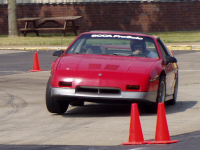Very basic questions
- andypugh
-

- Offline
- Moderator
-

- Posts: 19770
- Thank you received: 4600
A Bridgeport is getting a bit big for steppers (though it has to be admitted that when Bridgeport made their own CNC mills, they used steppers)
If you don't want to use steppers then the control electronics moves away from the bit-banged parport, either to EPP-controlled cards, or PCI or Ethernet.
I have generally started at the other end, seeing what motors I could find cheap on eBay, then working backwards towards the PC.
I converted a Harrison milling machine to CNC with 750W servo motors and that works nicely. A friend has converted the same machine with steppers, (NEMA 34) and that seems to be working. But the BP is a fair bit bigger.
I actually have the drives and motors from a CNC Harrison M250 lathe that I could do with getting rid of, but to be honest they are huge weak old steppers and large old unreliable stepper drivers, so can't really recommend them.
If you are converting a mill to CNC you probably need to swap the screws to ball-screws. Even if you don't do that immediately, design your conversion around an assumption ta=hat you will.
Lathes can get away with not having ball-screws a bit better, just because of the way lathes work, little lathe work involves a mid0cur direction reversal.
I have done three conversions of my own now, and one for someone else (in one day, at a meetup in Stuttgart). The first was the typical steppers and aluminium plate mounts, the second was a bit more elegant, and the last one cost me more in custom castings than the total cost of the first one.
So we can advise you how to do this, but it might help to know how much you expect to spend. I doubt you can do the Bridgeport for less than £300. But you could spend 10x that if you wanted.
Please Log in or Create an account to join the conversation.
- UKenGB
- Offline
- New Member
-

- Posts: 14
- Thank you received: 1
Over the few years I've had the Bridgeport I have become increasingly frustrated by not being able to tell it to make what I can design on computer. In essence, my aim is to be able to computer design and then machine fork yokes for motorcycles. Not as a business, but for my own projects. That's not all, but best describes my requirements.
With that in mind I began looking into this conversion some time ago and realised it would likely be cheaper to just buy a used CNC machine of some description - but where's the fun in that.
So I am resigned to the conversion being a more expensive option, but I will be happier keeping my Bridgeport and using an old PC I have kicking around to control it and I'm forming a picture in my mind as to what I need and already planned to convert to ball-screws.
Another really basic question then, what is the difference between stepper motors and step/dir controlled servos? Can either/both be driven from the built-in parallel port of my PC? Without EPP? Does EPP require different hardware or is it not just a different software driver?
Please Log in or Create an account to join the conversation.
- Todd Zuercher
-

- Offline
- Platinum Member
-

- Posts: 4693
- Thank you received: 1438
However servos and step motors have very different torque profiles. Step motors often have more low speed torque, but they quickly fizzle out and loose power with greater speed. Servos on the other hand can usually provide their rated torque all the way up to their maximum speed.
Servos also may have the option of providing position feedback to the control.
Servos will also usually need to be tuned for their application. This may or may not be a simple affair. Some servo drives can auto tune themselves reasonably well, but most will at a minimum require temporarily interfacing with a PC (usually with Windows) and then be configured using the manufacturers software.
Steppers are generally pretty much plug and play. (you might need to set micro-steps and motor current limits.)
Please Log in or Create an account to join the conversation.
- OT-CNC
- Offline
- Platinum Member
-

- Posts: 615
- Thank you received: 75
With that in mind I began looking into this conversion some time ago and realised it would likely be cheaper to just buy a used CNC machine of some description - but where's the fun in that.
So I am resigned to the conversion being a more expensive option, but I will be happier keeping my Bridgeport and using an old PC I have kicking around to control it and I'm forming a picture in my mind as to what I need and already planned to convert to ball-screws.
I would recommend finding a Bridgeport that is already cnc. One with bad electronics ready for upgrade. Often they can be found cheap depending on where you live in the world. The difficult part to make if you want to do your own conversion is the quill drive. That requires adding a ballscrew to the front of the head. Don't even think about driving the Z from the manual handle end.
Please Log in or Create an account to join the conversation.
- pl7i92
-

- Offline
- Platinum Member
-

- Posts: 1872
- Thank you received: 358
and the steel mold making the basement is still somhere in the world making Mashines
Please Log in or Create an account to join the conversation.
- andypugh
-

- Offline
- Moderator
-

- Posts: 19770
- Thank you received: 4600
My machines often make motorcycle parts, but not yokes as the bike I make parts for was made in 1921 and doesn't have forks, it has a front swingarm....my aim is to be able to computer design and then machine fork yokes for motorcycles.
Another really basic question then, what is the difference between stepper motors and step/dir controlled servos? Can either/both be driven from the built-in parallel port of my PC? [/quote]
Yes, both can be controlled with the parallel port of a PC. I wouldn't, but you can
Actually, you might as well start of with P-port + cheap breakout board, and some steppers. But you might find that (like me) you learn enough from that to know how you ought to have done it in the first place
Many servo drives require analogue +/-10V velocity control. That is something that you can't readily do with a parallel port. But LinuxCNC has a number of compatible interfaces that can do that, if you get a deal on some motors and drives. The drawback is that they cost $200 or more.
Please Log in or Create an account to join the conversation.
- UKenGB
- Offline
- New Member
-

- Posts: 14
- Thank you received: 1
Please Log in or Create an account to join the conversation.
- Leon82
- Offline
- Platinum Member
-

- Posts: 592
- Thank you received: 79
Please Log in or Create an account to join the conversation.
- RotarySMP
-

- Offline
- Platinum Member
-

- Posts: 1540
- Thank you received: 572
For my mill I used MESA 5i25/7i77/ to interface into the existing analog servos, and relay panel for gearbox, tool release, spindle start stop etc. As Andy said, the parallel port is okay for a little open loop router, but for a real mill, doing a closed loop servo set up, with enough I/O available for pendant, tool height setter, probe, coolant, mist, spindle speed control, fourth axis, tool release etc is a better solution.
Mark
Please Log in or Create an account to join the conversation.
- UKenGB
- Offline
- New Member
-

- Posts: 14
- Thank you received: 1
Please Log in or Create an account to join the conversation.
